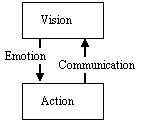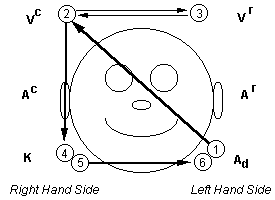Sequence of Accessing Cues for New Behavior Generator Strategy
metanymous в Metapractice (оригинал в ЖЖ)
Моделируем глазодвигатели, выпуск 28
| Оракул metapractice | |||||
| 43. Оракул metapractice | metanymous | ||||
| ... | bavi | ||||
| Сводные темы | |||||
| 18. НЛП, EMDR, ECEM, EMI, EMDR-НЛП-ЭГ | metanymous | ||||
| Ресурсы синестезий (n) Аберрации синестезии "Wish You Were" Pink Floyd | |||||
| Ресурсы синестезий (n) Аберрации синестезии "Wish You Were" Pink Floyd | metanymous | ||||
| Sequence of Accessing Cues for New Behavior Generator Strategy | metanymous | ||||
| Сводная тема | |||||
| 29. КГД субмодальностей «верх-низ» | metanymous | ||||
| Оракул metapractice | |||||
| 43. Оракул metapractice | metanymous | ||||
| ... | metanymous | ||||
Еще одна ассоциация связи техник(или усиление). Бендлеровский ГенераторНовогоПоведения это по сути техника импринтирования, потому что в технике ГНП есть:
- ролевое моделирование;
- фиксация убеждением;
- мощная кинестетика.
(сразу скажу, что технику не читал в оригинальном Бендлеровском описании - просто не нашел в сети. Но думаю, что ээээ оригинальное исполнение имеет в наличии этих три обязательных шага. Смешно звучит, но что делать). В Российском сегменте нлп намеков на эти обязательные шаги нет. Кто во что горазд.
офф. Если у метапрактиков есть техника ГенераторНовогоПоведения в описании Бендлера, то прошу - поделитесь, буду благодарен.
http://metapractice.livejournal.com/492280.html?thread=12687608#t12687608
New Behavior Generator Strategy
http://www.nlpu.com/Patterns/patt16.htm
One of the most essential processes of change is that of moving from a dream or vision to action. NLP has developed a kind of 'all purpose' creativity strategy, organized around the process of moving from vision to action, called 'The New Behavior Generator'. The basic steps to the New Behavior Generator were set out by John Grinder in the late 1970's.
The New Behavior Generator is an elegant strategy that can be applied to almost any situation that involves personal flexibility. The basic steps involve forming a visual image of a desired behavior, kinesthetically associating into the image on a feeling level, and verbalizing any missing or needed elements.

New Behavior Generator T.O.T.E.
These three steps form a feedback loop in which vision and action interact through the intermediate processes of emotion and communication.
The goal of the New Behavior Generator is to go through a type of mental 'dress rehearsal' by generating imaginary scenarios and bringing them to concrete actions by connecting the images to the kinesthetic representational system. The strategy is based on several key beliefs:
- People learn new behaviors by creating new mental maps in their brains.
- The more complete you make your mental maps, the more likely you will be to achieve the new behavior you want.
- Focusing on your goal is the quickest way to achieve new behaviors.
- People already have the mental resources they need to achieve new behaviors. Success is a function of accessing and organizing what is already there.
The New Behavior Generator is a 'How To' process that both expresses and supports these beliefs through the process of acting "as if". Like all NLP strategies, the New Behavior Generator follows a particular cognitive sequence, made up of processes involving the various sensory representational systems. Each step in the sequence is also supported by behavioral cues in the form of eye movements. These eye positions help to focus and stabilize the particular representational system to be accessed.
Basic Steps of the New Behavior Generator Strategy
The basic steps of the New Behavior Generator Strategy involve:
- Asking yourself, "If I could already achieve my new goal, what would I look like?"
(Do this while putting your eyes down and to your left.) - Picturing yourself achieving your goal. (Look up and to your right to help stimulate your imagination.)
- To help you visualize:
- Remember a similar successful achievement.
- Model someone else.
- Picture yourself first achieving a smaller part of the goal.
(Move your eyes up and to the left or right.)
- Stepping into the picture so you feel yourself doing what you pictured.
(Put your eyes and head down and to the right as you get into the feeling.) - Comparing these feelings to feelings from a similar past success.
(Keep your eyes and head turned down and to the right.) - If the feelings are not the same, name what you need and add it to your goal. Go back to step 1 and repeat the process with your expanded goal.
(Move your eyes and head down and to the left.)

Sequence of Accessing Cues for
New Behavior Generator Strategy
Detailed Description of the Steps of the New Behavior Generator Strategy
Each of the basic steps of the New Behavior Generator Strategy can be done with precision and rigor in order to enhance its practical effects. The following is a detailed description of each step in the strategy:
- Say to yourself, "If I was already able to...(state your goal)...what would I look like?" (Ad)
- Construct a visual image of what you would look like if you were in the act of achieving the full goal you have just stated. You should be seeing yourself in this image from a disassociated point of view as if you were above or next to yourself looking at yourself. (Vc)
- If you have trouble coming up with a clear image of yourself, use one of the following strategies:
- Chunk down your goal into smaller steps. Ask yourself, "Is there any portion of my goal that I can see myself achieving?" for instance, "Can I see myself accomplishing the first step of my stated goal?" Visualize yourself successfully achieving that smaller part of your goal. (Ad_>Vc)
- Use an image of yourself from a similar successful situation. Ask yourself, "Is there something similar to my goal that I can already achieve?" Visualize what you do in that situation and edit or modify the image to fit your current goal. (Ad_>Vr_>Vc)
- Model someone else. Ask yourself, "Who do I know that is already able to fully achieve the goal I have stated?" Visualize the what this other person does to be successful. Then visualize yourself doing what you just saw your model doing. (Ad_>Vr_>Vc)
- Mentally step inside of the image you created of yourself achieving your goal so that you feel as though you are doing right now what you just saw yourself doing. What would you be seeing, hearing and feeling? (Vc_>Kc)
- Compare the feelings you have as you put yourself fully into that experience with the feelings you identified earlier from a similar experience in which you are already successful. (Kc/Kr)
- Decision Point
- If the two feelings match exactly so that you feel as confident that you can achieve your new goal as easily as the goal you have already achieved successfully, then you are done.
- If the two feelings do not match then name what is missing or what is needed (i.e., "creativity," "more confidence," "be more relaxed," etc.).
- Apply the same rule to this statement of the needed resource that you applied to your initial goal statement. That is, state it positively. For example, if your statement of what is needed is "be less nervous," ask yourself, "If I could be less nervous what would I be doing instead?" (Ad)
- Refine your goal by taking the name of the needed resource that you have identified and adding it to your goal statement by simply connecting it with the word "and." For example, the goal statement may now be something like, "I want to be more assertive with my co-workers (initial goal statement) AND keep in mind their feelings as well." Go back to step #1 and repeat the strategy. (Ad)

Specific Steps of the New Behavior Generator Strategy
NOTE: You may add any number of needed resources to your goal statement so that when you are done you may have refined your goal to something like: "I want to be more assertive with my co-workers AND keep their feelings in mind as well AND maintain a sense of my own self confidence AND remain cool if someone gets angry."
References
Tools for Dreamers, Dilts, R. and Epstein, T., Meta Publications, Capitola, CA, 1991.
Also see the Article of the Month or the Archives if you are interested in checking out NLP in more depth.
For information on Robert Dilts’ products and services, please see Upcoming Seminars or Robert’s Product Page or return to Home Page. If you have problems or comments concerning our WWW service, please send e-mail to the following address: michaelp@bowsprit.com.
This page, and all contents, are Copyright © 1998 by Robert Dilts., Santa Cruz, CA.
7 комментариев
сначала старые сначала новые
Construct a visual image of what you would look like if you were in the act of achieving the full goal you have just stated. You should be seeing yourself in this image from a disassociated point of view as if you were above or next to yourself looking at yourself. (Vc)
Предлагают увидеть себя со стороны, в качестве/со свойствами «быть способным» на нечто, на что ранее вы не были способны.
Дилтс считает, что для этого годится Vc из ключей КГД.
Мы же считаем, что любая форма видения себя со стороны с необычным способностями есть некоторая зрительная ~синестезия между Vc и Vr.
Нужно сравнить ощущения, которые были до техники и после?
Не совсем понимаю, что здесь написано
Decision Point
If the two feelings match exactly so that you feel as confident that you can achieve your new goal as easily as the goal you have already achieved successfully, then you are done.
If the two feelings do not match then name what is missing or what is needed (i.e., "creativity," "more confidence," "be more relaxed," etc.).
Не понял вашего вопроса: критерий завершения рефрейминга?
Нужно сравнить ощущения, которые были до техники и после?
Ну, в любом варианте это референция/проверка ощущений.
--Не совсем понимаю, что здесь написано
--Decision Point
If the two feelings match exactly so that you feel as confident that you can achieve your new goal as easily as the goal you have already achieved successfully, then you are done.
If the two feelings do not match then name what is missing or what is needed (i.e., "creativity," "more confidence," "be more relaxed," etc.).
Ну, в цитате речь идёт о сравнении ощущений от примера, в котором есть образец достижения целей из прошлого и ощущений которые связаны с новым способом (созданным в технике) достижения целей.
Как-то так.
Я представляю как я веду себя по-новому диссоциированно, затем ассоциируюсь в это опыт и ощущаю как это вести себя по-новому?
Не понял вашего вопроса: критерий завершения рефрейминга?
Да. Если появляются какие-то внутренние возражения насчет нового опыта, то я перевоображаю его до того момента, пока не будет удовлетворяющей К?
И это будет критерий завершения рефрейминга?
Кстати, в более поздней литературе, в кн. Трансформейшн и Рефрейминг эта идея/компонента техники была расписано более подробно.